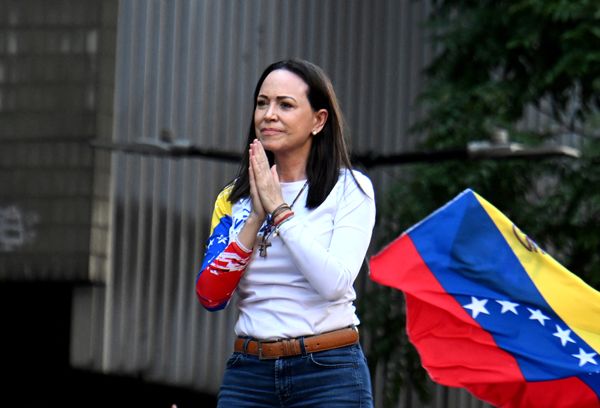
If you ask for directions in Philadelphia’s Chinatown, chances are someone will either tell you to head “north of the highway” or “south of the highway”. That’s because this community has been carved into two.
It is one of the oldest and largest Chinatowns in the US. Yet landmarks like the Holy Redeemer church and the Crane community center are separated from others – like the famous dim sum spot Bai Wei or the Chinatown firehouse – by six lanes of busy traffic.
This freeway is known as the Vine Street Expressway. “This is the busiest [area] for Chinatown,” said Debbie Wei, who founded the grassroots activist group Asian Americans United. “It’s a pretty broad space to have to cross over.” Several times a week she crosses the sunken highway via one of six street-level lanes. “It’s not the sort of place where residents think: ‘Oh, I think I’ll take a walk here.’”
But all that could change thanks to an audacious plan to physically cover the expressway and reconnect the two severed parts of Chinatown. Last month, the city announced plans to explore a “cap”, a structure built on top of a highway that acts as a lid, and would make way for new green areas, recreational space and even buildings.
The city has allocated $400,000 to explore what local residents want the cap to look like. It has also secured $4m to design it, including $1.8m in federal funds from President Biden’s bipartisan infrastructure law. Construction on the project – known as the “Chinatown stitch” – is estimated to start in 2028.
“This is something that the community has been organizing around for three decades now,” said Christopher Puchalsky, who oversees policy and planning for Philadelphia’s office of transportation, infrastructure and sustainability. “On top of noise pollution and air pollution, as pedestrians cross back and forth, the fast traffic they encounter is dangerous.”
It follows other plans to reconnect communities like those in New York’s South Bronx, through capping portions of the Cross Bronx Expressway. A similar plan is under way in Richmond, Virginia, where the city has secured $1.3m to plan the capping of parts of I-95 that cut through Jackson Ward. Thousands were displaced in the historic Black neighborhood when the highway was built in the 1950s.
The Federal Highway Act of 1956 initiated construction of 41,000 miles (66,000km) of the interstate highway system and reshaped travel and trade in the US. But this convenience came at a cost, including air and noise pollution, safety risks from vehicle collisions, and even increases in traffic congestion.
Communities of color bore the brunt of the devastation that came with highway construction. In the 1920s, the urban planner Robert Moses spearheaded the bulldozing of Black and Latino neighborhoods in New York City to make way for expressways. And while the Civil Rights Act of 1964 outlawed segregation, the design of these highways perpetuated racial zoning that destroyed homes, devalued property and separated communities.
One such place that was shaped by highway infrastructure in this way is Philadelphia’s Chinatown.
The very first Philadelphia Chinatown business dates back to 1870, when Lee Fong started a laundry storefront at 913 Race Street, less than a mile away from city hall and the Liberty Bell. Amid growing anti-Asian sentiment, discriminatory immigration laws like the Chinese Exclusion Act of 1882 prevented all but merchants from bringing families into the country. As the restrictions eased, Chinese immigrants settled there with their families, built businesses and founded churches and schools that, despite facing challenges from new development projects, still thrive today.
In 1966, the city released a plan to extend Philadelphia’s Vine Street Expressway and link a growing part of the south-west of the city to the Benjamin Franklin Bridge, which crosses the Delaware River into downtown Camden, New Jersey. The construction of the highway required the seizure of more than 300 properties through eminent domain and demolished entire blocks of houses and businesses, splitting the community north and south of the highway.
“It created an artificial barrier that stunted the physical expansion of Chinatown,” said John Chin, executive director of the Philadelphia Chinatown Development Corporation (PCDC), an organization founded in 1968 to represent the community’s opposition to the highway.
“I have friends that I grew up with who had to move out of the community,” said Chin. “Some were lucky and were able to move into replacement housing, and that’s something PCDC’s founders had fought for – if you’re going to force us to move, you need to build new housing so we can stay in Chinatown.”
The original plan entailed demolishing the Holy Redeemer Catholic church and an adjacent school, both serving a majority Asian population. But thanks to the overwhelming and united pressure from the community, the church and the school survived. Today more than 300 people attend Holy Redeemer’s Sunday mass, and roughly 150 children are enrolled in the K-12 school.

“The current situation is an environmental justice issue,” said Puchalsky of the city of Philadelphia. In formulating the Chinatown stitch, “we’re determined not to make the same mistakes,” he said.
Currently there are efforts to survey the community, notably in Mandarin as well as in English. So far, residents have expressed a desire for green space and parks which are lacking in Chinatown, as well as stressing the importance of pedestrian safety. Other green spaces that have resulted from highway capping include Klyde Warren Park in Dallas, Texas; Freeway Park in Seattle, Washington; Lyle Park in Cincinnati, Ohio; and Sutton Park in New York City.
“I think it’s a small token of recognition of what’s happened to the community,” said Wei. “There’s very little to no green in Chinatown, and the exhaust from cars alone is environmentally detrimental to the people.”
But even as Chinatown seems on the verge of reunification, some say another threat looms.
The community is rallying to stop a proposed 18,500-seat basketball arena for the Philadelphia 76ers on Chinatown’s doorstep. It is the second attempt to build a stadium in the neighborhood – in 2000, Wei and others rallied against a baseball arena for the Philadelphia Phillies.
The new privately funded $1.3bn arena is spearheaded by 76 Devcorp, run by Philadelphia 76ers owners Josh Harris and David Blitzer as well as the billionaire developer David Adelman. The lease on the NBA team’s current arena expires in 2031, and the developers have stated that “the current location is not conducive to our vision of building a championship-level franchise for decades to come.” They also noted that “most arenas only remain in service for 30-40 years,” which is prompting concern in Chinatown that their community will suffer displacement again only to have the arena shutter after a few decades.
The PCDC, which opposes the arena, surveyed more than 90% of Chinatown residents and businesses, finding overwhelming opposition. In a statement, the organization cited fears of gentrification, which has repeatedly been the case when stadiums are built in neighborhoods largely home to people of color. Additionally, residents expressed concern about displacement, increased rent, and parking and traffic congestion.
“It would kill Chinatown,” said Wei.
The neighborhood already faces a demographic shift. It is home to nearly 5,000 people, and roughly 50% of the population is of Asian descent, having declined from 58% in 2000. This situation is similar in New York City, where factors like high rent drove out roughly 10% of the Asian population of Manhattan’s Chinatown between 2010 and 2020. From 2010 to 2017, the number of Asian people in San Francisco’s Chinatown, the nation’s first, decreased by 6%.
But perhaps the most dire example of how gentrification and development have erased a community is seen in Washington DC’s Chinatown. Founded in the 1930s, it is now a shell of what it was, with fewer than 300 Chinese Americans living there today. The construction of what’s known today as the Capitol One Arena in 1997 drove out businesses with locals following suit.
Chin, of the PCDC, fears that the same thing will happen in Philadelphia if the proposed 76ers arena is built.

“It’s the saddest thing I’ve seen,” said Chin, recalling walking in what remains of DC’s Chinatown and not finding a single Asian supermarket. “A community in the US capital became an empty town.”
For now, even though the cap is poised to address some of the harms wreaked by the highway, locals like Debbie Wei are worried about the future of Chinatown. And much like before, they’re determined to fight.
“Chinatown is a real community, in the deepest sense,” Wei said. The stadium developers “keep saying that this isn’t going to have an impact, that it’s going to help us. But if you’re that confident, then do a full impact study and show us the evidence that this will work – environmentally, socially, culturally – that our community will stay intact,” she said. “Show us that.”







